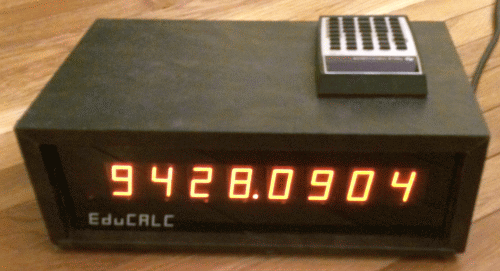There is a new kind of calculator being manufactured. It's an EduCALC,
a teaching calculator with two display units. It has the usual small, red
numerical readout facing you as you operate it, and also it has another
BIG display unit showing the same number in the opposite direction
toward your audience or class. Its big, bright neon digits have that
same twinkling fascination for the viewer that has attracted him to his
own calculator.
Anyone who has tried to communicate numbers and calculations to other
people knows the problem. The display digits are just too little to
be read if you hold the calculator up to be seen, even before a small
audience. Yet reading off the numbers loses attention and interest,
and so does writing them on a blackboard. The EduCALC gives us a way to
really hold an audience, a way to give our calculations "sex appeal."
This important new visual aid for teaching is in use at the University of
California, for example. They have found that it captures the attention
of students all the way to the rear of a large, well-lit lecture theater.
The "Master" Calculator: Each EduCALC has its own built-in
calculator. These calculators are made by Hewlett-Packard. Three different
EduCALC models are available:
| Model | | Master |
|---|
| 21 GD | | HP-21 Scientific Calculator |
| 22 GD | | HP-22 Business Management Calculator |
| 25 GD | | HP-25 Programmable Scientific Calculator |
The "Slave" Display: When 115 VAC is supplied, the big display lights
up toward the audience. This display is formed of planar gas discharge
digits made by Beckman Instruments. They have a wide viewing angle of
130°, a spectacular legibility at 60 feet (18 meters) distance, and a
life expectancy of ten years or more.
The Cabinet and Accessories: The EduCALC cabinet is an oak lectern which
contrasts with the black face of the big display. It comes complete with
a carrying case that doubles as a pedestal with which you can elevate
the lectern above desk height. Also included with each EduCALC are the
Owner's Manual and/or Application Handbook which are normally supplied
with its master calculator.
The Interface Electronics: The EduCALC needs to electronically modify
and amplify the signal levels and format of the pocket calculator
display before they can be used to drive the big neon display. Medium
Scale Integrated (MSI) circuits are used to demultiplex and buffer the
calculator output. The engineering is conservative; each EduCALC is
built and tested to function reliably for many years.
The Warranty: Each EduCALC is warranted against defects in materials
and workmanship for one year from date of delivery.
Compared to computers, the EduCALC gives a really inexpensive teaching
system. Students buy their own calculators, so the only expense is the
EduCALC itself. Yet this system gets even more student involvement,
more excited interest in the math.
This is a dramatic new sales, lecturing, and teaching tool. It costs no
more than a good office typewriter. Many teachers have found that the
money was readily available to them in budgets marked for "Innovative
Projects" or "Curricular Development," as well as in the more customary
"Audio Visual" or "Supplies and Equipment" accounts.
The price for the programmable model, the 25 GD, is $950 including
delivery in the U. S. A. The 21 GD is $855, and the 22 GD sells at
$920. There is a 15 day trial period during which you may return the
machine to obtain a full refund if you are not satisfied.
 I have a teaching calculator made from a set of large Panaplex
displays interfaced to a Texas Instruments scientific calculator.
I have a teaching calculator made from a set of large Panaplex
displays interfaced to a Texas Instruments scientific calculator.